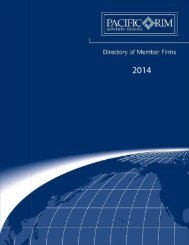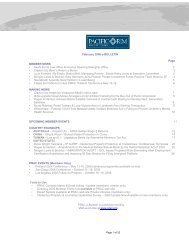A Guide to the Law of Securitisation in Australia - Clayton Utz
A Guide to the Law of Securitisation in Australia - Clayton Utz
A Guide to the Law of Securitisation in Australia - Clayton Utz
- No tags were found...
You also want an ePaper? Increase the reach of your titles
YUMPU automatically turns print PDFs into web optimized ePapers that Google loves.
8 Set-<strong>of</strong>f and securitisation8.1 IntroductionA common type <strong>of</strong> securitisation <strong>in</strong> <strong>Australia</strong> <strong>in</strong>volves an ADIsell<strong>in</strong>g (by way <strong>of</strong> an equitable assignment) a pool <strong>of</strong> its loans oro<strong>the</strong>r receivables <strong>to</strong> a special purpose vehicle (usually a trustee).Typically, <strong>the</strong> ADI rema<strong>in</strong>s as servicer <strong>of</strong> <strong>the</strong> loans and <strong>the</strong> ADI’scus<strong>to</strong>mers are unaware <strong>of</strong> <strong>the</strong> assignment. Cus<strong>to</strong>mers will onlybe given notice <strong>of</strong> <strong>the</strong> assignment if <strong>the</strong> special purpose vehicleperfects its title <strong>to</strong> <strong>the</strong> loans (ie. it takes a legal assignment <strong>of</strong><strong>the</strong> loans).Set-<strong>of</strong>f is an important issue where ADIs securitise <strong>the</strong>ir assets.In particular, <strong>the</strong> issue is whe<strong>the</strong>r a cus<strong>to</strong>mer, on its ADIbecom<strong>in</strong>g <strong>in</strong>solvent, can set <strong>of</strong>f <strong>the</strong> amount stand<strong>in</strong>g <strong>to</strong> <strong>the</strong> credi<strong>to</strong>f its deposit account(s) with <strong>the</strong> ADI aga<strong>in</strong>st <strong>the</strong> cus<strong>to</strong>mer’s loanassigned by <strong>the</strong> ADI <strong>to</strong> <strong>the</strong> special purpose vehicle.The rat<strong>in</strong>g agencies and <strong>in</strong>ves<strong>to</strong>rs are pr<strong>in</strong>cipally concerned withthis issue. It is important that <strong>the</strong> special purpose vehicle’s assets(ie. <strong>the</strong> assigned loans) are not detrimentally affected by (and are<strong>in</strong>sulated from) <strong>the</strong> ADI’s <strong>in</strong>solvency.The follow<strong>in</strong>g sections deal with <strong>the</strong> four types <strong>of</strong> set-<strong>of</strong>f(statu<strong>to</strong>ry set-<strong>of</strong>f, equitable set-<strong>of</strong>f, contractual set-<strong>of</strong>f and<strong>in</strong>solvency set-<strong>of</strong>f), mutuality <strong>in</strong> set-<strong>of</strong>f, contract<strong>in</strong>g out <strong>of</strong> set-<strong>of</strong>fand, <strong>in</strong> conclusion, <strong>the</strong> application <strong>of</strong> <strong>the</strong>se pr<strong>in</strong>ciples <strong>to</strong> <strong>the</strong>resolution <strong>of</strong> this issue.8.2 Statu<strong>to</strong>ry set-<strong>of</strong>fThe statu<strong>to</strong>ry right <strong>of</strong> set-<strong>of</strong>f is based upon <strong>the</strong> English Statutes<strong>of</strong> Set-Off <strong>of</strong> 1729 and 1735. These were <strong>in</strong>corporated <strong>in</strong><strong>to</strong> <strong>the</strong>law <strong>of</strong> <strong>the</strong> <strong>Australia</strong>n States when <strong>the</strong>y were established asBritish colonies. They have s<strong>in</strong>ce been repealed <strong>in</strong> New SouthWales and Queensland (although it is arguable that <strong>in</strong>Queensland <strong>the</strong> pr<strong>in</strong>ciples <strong>of</strong> statu<strong>to</strong>ry set-<strong>of</strong>f still apply). In allo<strong>the</strong>r States, <strong>the</strong> Statutes <strong>of</strong> Set-Off rema<strong>in</strong> <strong>in</strong> operation.The statu<strong>to</strong>ry right <strong>of</strong> set-<strong>of</strong>f is a defence <strong>to</strong> an action forpayment <strong>of</strong> a debt ow<strong>in</strong>g by <strong>the</strong> defendant <strong>to</strong> <strong>the</strong> pla<strong>in</strong>tiff. Itenables <strong>the</strong> defendant <strong>to</strong> set <strong>of</strong>f aga<strong>in</strong>st <strong>the</strong> pla<strong>in</strong>tiff’s claim <strong>the</strong><strong>in</strong>debtedness <strong>of</strong> <strong>the</strong> pla<strong>in</strong>tiff <strong>to</strong> <strong>the</strong> defendant.Statu<strong>to</strong>ry set-<strong>of</strong>f only applies where both demands are liquidatedand are due and payable before <strong>the</strong> date <strong>of</strong> <strong>the</strong> relevant action.The claims that we are consider<strong>in</strong>g here (ie. <strong>the</strong> cus<strong>to</strong>mer’s<strong>in</strong>debtedness <strong>to</strong> an ADI under its loan and <strong>the</strong> ADI’s liability for<strong>the</strong> amount <strong>of</strong> <strong>the</strong> cus<strong>to</strong>mer’s deposit accounts <strong>in</strong> credit) wouldnormally satisfy both <strong>of</strong> <strong>the</strong>se requirements. The claims must alsobe mutual. Mutuality is discussed <strong>in</strong> section 8.6.8.3 Equitable set-<strong>of</strong>fEquitable set-<strong>of</strong>f was developed by <strong>the</strong> Courts <strong>of</strong> Equity <strong>to</strong>protect a party denied statu<strong>to</strong>ry set-<strong>of</strong>f where this would result<strong>in</strong> an <strong>in</strong>justice or an <strong>in</strong>equitable result. The classes <strong>of</strong> equitableset-<strong>of</strong>f are not closed and <strong>the</strong>re are some differences between<strong>the</strong> approach adopted by <strong>the</strong> courts <strong>in</strong> England and <strong>Australia</strong>.However a prerequisite for <strong>the</strong> application <strong>of</strong> equitable set-<strong>of</strong>f isnormally that ei<strong>the</strong>r:• <strong>the</strong> claim and <strong>the</strong> cross-claim arise out <strong>of</strong> <strong>the</strong> sametransaction; or• <strong>the</strong> claim and cross-claim arise out <strong>of</strong> transactions that are<strong>in</strong>separably connected.It appears (although <strong>the</strong> authorities diverge on this po<strong>in</strong>t) that<strong>the</strong> courts may also require that <strong>the</strong> cross-claim must impeach<strong>the</strong> claim. That is, it may not be sufficient that <strong>the</strong> claim and <strong>the</strong>cross-claim arise out <strong>of</strong> <strong>the</strong> same or <strong>in</strong>separably connectedtransactions, but ra<strong>the</strong>r <strong>the</strong> cross-claim must <strong>in</strong> some wayunderm<strong>in</strong>e <strong>the</strong> very basis <strong>of</strong> <strong>the</strong> claim.In addition, an equitable set-<strong>of</strong>f may be denied by <strong>the</strong> courts evenwhere <strong>the</strong>se tests have been satisfied, if <strong>in</strong> <strong>the</strong> circumstances, itwould be unjust or <strong>in</strong>equitable <strong>to</strong> allow a set-<strong>of</strong>f <strong>to</strong> occur.There have been mixed results <strong>in</strong> cases where equitable set-<strong>of</strong>fhas been claimed <strong>in</strong> defence <strong>to</strong> <strong>the</strong> enforcement <strong>of</strong> a mortgageloan.In some cases <strong>the</strong> courts have protected <strong>the</strong> mortgagee’s right <strong>to</strong>repayment <strong>of</strong> <strong>the</strong> mortgage debt free <strong>of</strong> set-<strong>of</strong>f. In o<strong>the</strong>r cases<strong>the</strong> courts have permitted a cus<strong>to</strong>mer <strong>to</strong> set <strong>of</strong>f its mortgage debtaga<strong>in</strong>st damages for breach <strong>of</strong> contract where (<strong>in</strong> one case) <strong>the</strong>breach rendered <strong>the</strong> cus<strong>to</strong>mer unable <strong>to</strong> repay <strong>the</strong> mortgage debtand (<strong>in</strong> ano<strong>the</strong>r case) <strong>the</strong> claim for damages far exceeded <strong>the</strong>mortgage debt. It is conceivable that a default by an ADI on adeposit account could produce a similar result <strong>to</strong> ei<strong>the</strong>r <strong>of</strong> <strong>the</strong>sefact situations. An equitable set-<strong>of</strong>f <strong>of</strong> a deposit account aga<strong>in</strong>sta mortgage loan might be available, for <strong>in</strong>stance, <strong>in</strong> <strong>the</strong> follow<strong>in</strong>gcircumstances:• an ADI may <strong>of</strong>fer <strong>to</strong> cus<strong>to</strong>mers <strong>the</strong> ability <strong>to</strong> <strong>of</strong>fset <strong>the</strong><strong>in</strong>terest liability on <strong>the</strong>ir mortgage loan aga<strong>in</strong>st <strong>the</strong> <strong>in</strong>terestearned on a nom<strong>in</strong>ated deposit account. Such an accountcould be construed as <strong>in</strong>separably connected with <strong>the</strong>correspond<strong>in</strong>g mortgage loan from <strong>the</strong> ADI; or48






